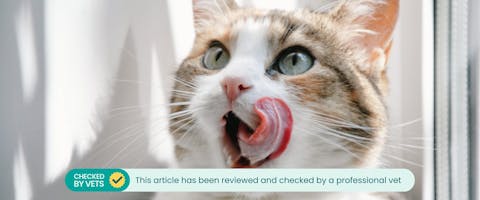Updated 22/11/2023
Ever wondered why your feline friend’s tongue feels more like the scratch of sandpaper across your skin than a comforting lick of love? We’re here to discover the answer to “Why are cats' tongues rough?”, uncovering the whisker-licking science behind these fascinating muscular organs and the mind-boggling things these tongue-twisting tools can do. Cat got your tongue? Don’t worry, we’ll fill you in on all of the jaw-dropping details!
Why are cats’ tongues rough? The anatomy
A cat’s tongue is no ordinary tongue, in fact, it’s a textured tool used for a variety of purposes. It’s not soft like ours, it’s scratchy and spiky to the touch and feels a bit like sandpaper on our skin. “Why do cats' tongues feel like sandpaper?” we hear you ask. This is because our feline friends’ tongues are covered in tiny, hollow spines called papillae, which are curved towards the back of a cat’s mouth. These backward-facing spines are made of keratin, the same protein found in our nails, which explains why a cat’s tongue can feel rough and scratchy. Big cats like tigers, lions, and cougars all have these same spiky tongues, which leads us to believe that papillae serve a purpose other than making our hairs stand on end…
Trending posts
Purr-use some of the top blogs our members have been loving this month- Top male dog names for your new furry friendGot a new furry family member in your pack? Check…

- Top female dog names for your new fluffy palWelcoming a new pooch into your family? Explore…

- 120+ gray cat names your silver feline will loveRecently welcomed a fluffy gray bundle of joy into…

- What are normal pet sitting rates?Discover the average pet sitting rates for animals…

- Unique dog names to stand out from the packDare to be different with our list of the best…

Why are cat tongues rough? The explanation
So what’s the point in those tiny little cat tongue spikes? There are four main theories for your cat’s rough tongue: eating, drinking, grooming, and keeping cool.
Eating and drinking
When we asked “Why are cats’ tongues so rough?” this answer was probably on the tip of your tongue. In case you forgot, your domesticated kitty was once a wild animal, and the papillae found on your puss pal’s tongue help them to strip meat clean off the bone to get the maximum nutrition from their prey. While your feline friend is probably more likely to be nibbling on a bowl of kibble nowadays, cats are obligate carnivores, so their bodies are designed to be meat-eating machines! The papillae covering their rough tongues also play a part in scooping up water droplets when cats are drinking.
Grooming
Ok, we don’t really feel like we’re letting the cat out of the bag by telling you our feline friends use their tongues to eat and drink, but here’s where things get interesting. Pet parents and seasoned sitters will know that cats spend a lot of time grooming, and sometimes as much as 50% of their waking hours is taken up with cleaning and preening. During their luxuriously long grooming routines, cats use the curved papillae on their tongues to remove loose hairs and clean away dirt, debris, and even parasites. The papillae rotate at the base, giving them a flexible, comb-like tongue that reaches right to the root of their hairs to give them a good old scrub. So “Why do cats have scratchy tongues?”. It could all be down to self-care.
Keeping cool
Cats lick their fur a lot, but is this just down to grooming? A study from 2018 suggests that the papillae on cats’ tongues play a part in lowering their temperature. The tips of the papillae are used for wicking saliva and depositing it deep into the root of the cat’s fur, and scientists found that this had the potential to generate “a temperature difference of up to 17° C between skin and topcoat”. So aside from keeping fluffy felines looking fur-tastic, a cat’s rough tongue could also help them regulate their body temperature.
So there you have it, four theories answering the question “Why do cats have rough tongues?”. From the science behind your furry friend’s magical muscle to the various tongue-twisting tasks it helps out with, it’s fair to say that a cat’s rough tongue is pretty impressive. Find out more about the magical world of pets over on our blog, where wonderfully weird cat behaviors are explained and we explore why cats are so cute!
Meet our veterinary expert, Aisling
This article has been checked by veterinarian Aisling O’Keeffe MVB CertSAM ISFMCertAdvFB. Aisling qualified as a vet 7 years ago from University College Dublin. She has worked in a mixture of UK small animal hospitals along with Irish practices. She worked for 3 years in a feline-only hospital where she further developed her feline medicine and surgery skills. She currently lives and works in a small animal hospital in Cork, Ireland.

